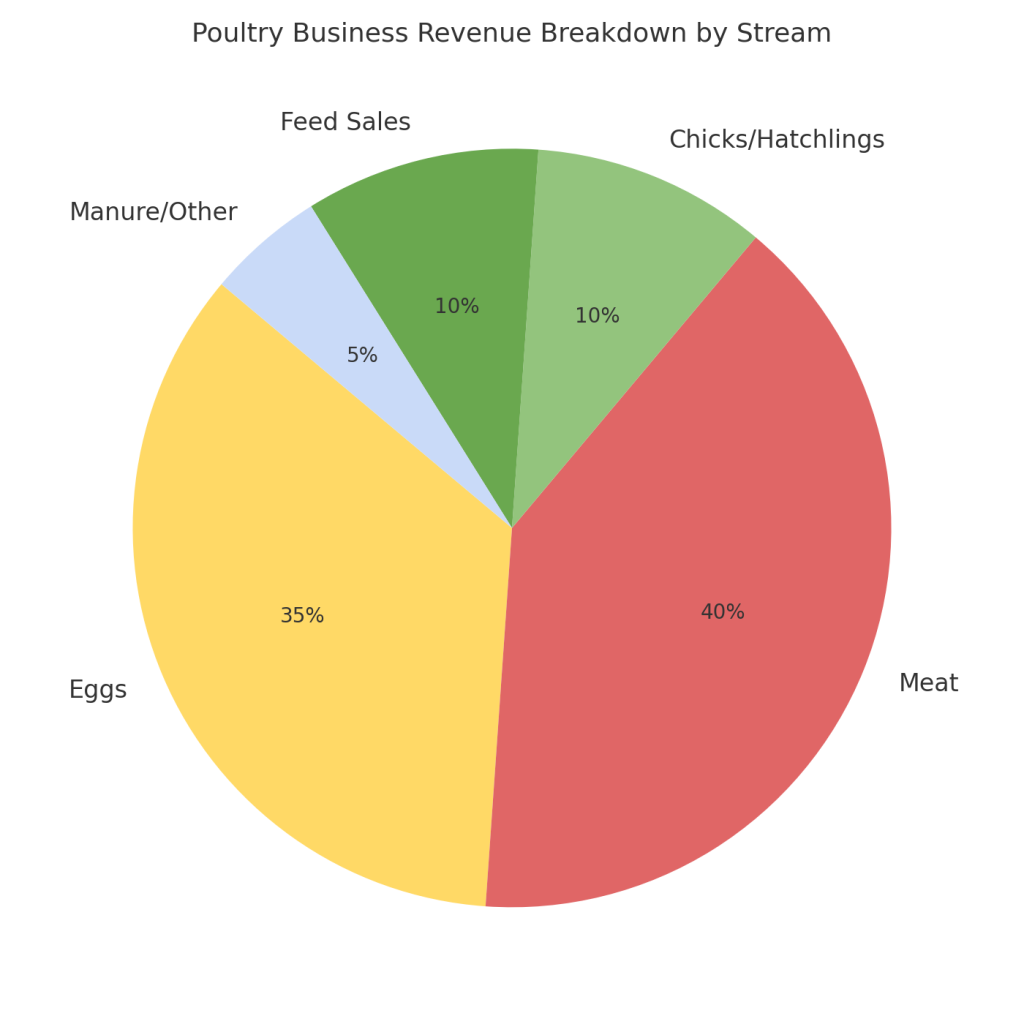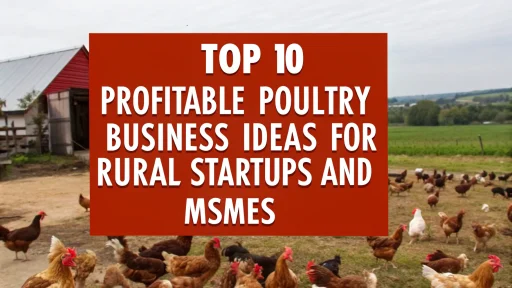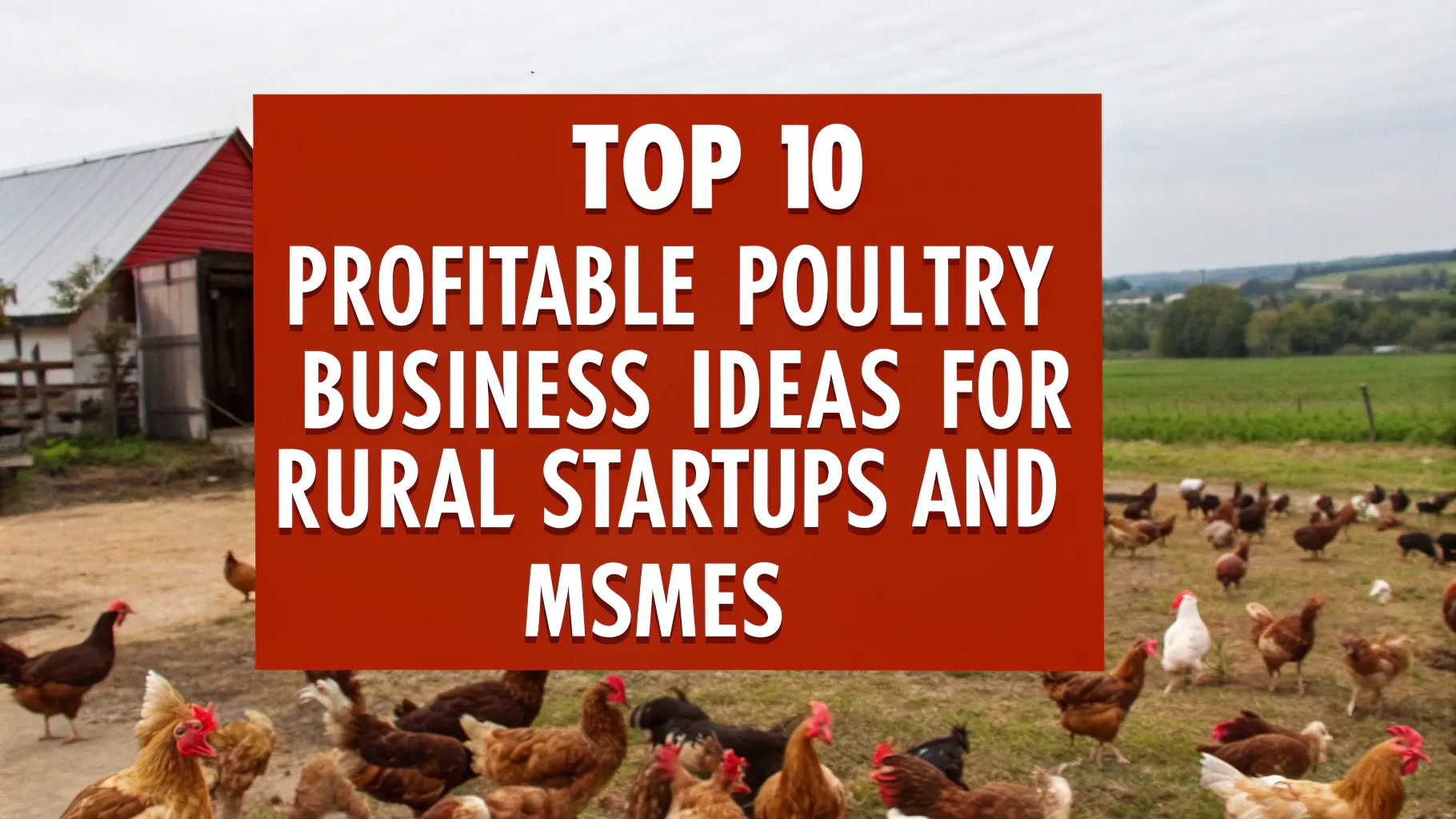India’s poultry business is undergoing an important transformation. It was once a modest rural livelihood, but it has evolved into a vibrant agricultural segment. India is one of the top producers in the world for both chicken meat as well as eggs. This presents a great opportunity for rural startups and MSMEs to expand their operations along the entire poultry value chain.
The demand for poultry products is increasing as income levels increase. With the help of government schemes, better veterinary access, and the development of cold-chain facilities, the poultry sector has grown to be one of India’s most profitable agricultural sectors.
This article explores 10 of the most profitable chicken business ideas for rural entrepreneurs and startups, providing insights into market potential, processing techniques, and the overall growth trajectory of the sector.

Sector Overview and Market Outlook
India’s chicken market is predicted to grow at an annual compound growth rate of more than 8% from 2024-2029. The market is currently worth more than Rs 2.8 lakh cr. It’s driven by an increased demand for protein, a growing quick-service restaurant sector, and a growing adoption of packaged and processed products.
Here’s a quick snapshot of expected growth in key sub-segments for poultry:
| Poultry Segment | 2024 Value (Rs. Cr. | Estimated value (Rs. Cr., 2029). | CAGR (%) |
| Broiler Meat | 1,45,000 | 2,17,000 | 8.4 |
| Egg Production | 57,000 | 85,200 | 8.3 |
| Poultry Feed | 80,000 | 1,24,500 | 9.3 |
| Processed poultry products | 5,000 | 10,500 | 15.8 |
| Byproducts and Value Additions | 2,500 | 4,900 | 13.7 |
1. The Egg Layer Farming Business: Daily Income Stream
The egg farming industry is one of the most reliable and consistent poultry ventures in rural areas. This model is suitable for both small backyard units as well as large-scale layer farms, thanks to its low entry barrier and high demand in urban markets.
The process starts with the raising of day-old layers, which begin laying around 18-20 weeks. To ensure high productivity, farmers focus on balanced nutrition, a clean environment, and regular vaccinations. Daily egg collection provides income for more than 12 months.
Layer farming has become a key business in India, with its rural relevance as well as urban market links. India’s egg consumption per capita is increasing, and consumers are increasingly looking for protein-rich foods.
2. Broiler chicken farming: High demand, fast turnaround
Broiler farming offers shorter production cycles, and faster returns to entrepreneurs. This allows for up to six cycles per year.
The operation revolves around breed selection, such as Hubbard or Cobb, climate-controlled housing, and feed efficiency. The final product is sold to butcher shops or meat processors.
Broiler farming is one of the best opportunities for startups looking to scale quickly, given the growing demand for chickens from restaurants, cities and cloud kitchens.
3. Poultry Feed Manufacturing – The Backbone of an Industry
The cost of feed is the largest recurring expense in poultry farming. In order to meet this demand, reliable and efficient poultry feeds are in high demand. Entering the feed industry is a great way for MSMEs to tap into a reliable and essential market.
The business is involved in the creation of balanced feed mixes using ingredients such as maize, soybean meal and rice bran. The production process involves grinding, mixing and pelletizing, followed by quality control and distribution.
Custom feeds can be developed for organic, broiler, and layer poultry. Feed manufacturing is a key industry that supports the rapidly expanding poultry sector.
Related: Profitable Poultry & Cattle Feed Business Opportunities
4. Hatchery Operation: Breeding The Next Generation
Hatcheries are special units that produce chicks of a day’s age for farms. This is a highly technical, but scalable, business where success depends on breeding accuracy, biosecurity, and incubation accuracy.
Entrepreneurs create a breeding program. They collect fertilized eggs and incubate it in controlled conditions for 21 days. After hatching, the chicks will be vaccinated before being sold to backyard poultry units or commercial farms.
This model is a good fit for bulk sales contracts and seasonal spikes in demand. A hatchery that is well managed in a district with a high poultry density can be the lifeline of multiple farms and cooperatives.
5. Poultry Meat Processing and Cold Chain Unit
Local processing infrastructure is becoming more important as consumer tastes shift towards clean, pre-cut, and packaged poultry. This opens the door to hygienic killing, portioning and vacuum packaging.
To set up a small-scale processing unit, you will need to purchase live birds from local farmers, ensure that they are slaughtered according to food safety standards, and maintain the integrity of the cold chain. The packaged meat can be sold directly to supermarkets, restaurants, or delivery apps.
This model is in line with the urban retail market and government efforts to ensure food safety. Startups in rural or periurban areas can consider franchise models for niche markets such as organic or halal chicken.
6. Egg Powders and Liquid Egg Products
India’s egg shortage and waste issues make egg processing an attractive B2B business opportunity. The use of liquid and powdered eggs is widespread in food ingredients, airline rations, bakery chains, and military rations.
The process involves breaking eggs, separating yolk from white, pasteurizing liquid and spray drying, or packaging. These products are ideal for institutional and export sales because they have a long shelf life.
This niche market promises steady bulk orders and high margins as the demand for convenience protein and long-storage proteins grows, especially in the food service industry.
7. Organic and free-range poultry farming
This model is based on the raising of birds without antibiotics or synthetic feed. The birds are free to roam and are fed organic food. The organic eggs and chicken are sold to restaurants and health-conscious consumers.
Organic products deliver greater returns on investment because they command premium prices in both domestic and international markets.
As a result, entrepreneurs in Tier-1 cities and tourism-driven areas can gain the most. This is especially true if they can brand and tell stories that focus on animal welfare and sustainability.
8. Eggshell Powder Manufacturing
The eggshell waste that is often thrown away by bakeries and commercial kitchens contains a lot of calcium carbonate. Eggshell powder can be produced by collecting, sterilizing, drying and finely milling eggshells. This powder is used in pet food, health supplements and fertilizers.
The business can be run in conjunction with egg farms or bakeries. Nutraceutical brands, ayurvedic products, and export markets seeking natural calcium sources are all possible market segments.
Waste-to-wealth initiatives offer profitability and sustainability.
Related: Eggshell Powder Manufacturing Business
9. Composting Units and Craft Units for Chicken Feathers
Chicken feathers, which are often discarded as waste, can be used in a variety of ways. You can compost them into organic manure rich in nitrogen or use them to make pillows, quilts and other handicrafts.
Composting feathers is a straightforward bio-degradation, but for crafts and stuffing, it may be necessary to dry, clean, and sort the feathers. This model offers creative employment in rural clusters by supporting both micro-enterprises as well as self-help groups.
The finished products can also be sold in organic stores, at fairs or exported as eco-friendly goods.
10. Poultry-based Ready-to-Eat Snack Manufacturing
The value-added model is used to create snacks such as chicken nuggets or wings, or sausages. This segment is growing due to urbanization and busy lives.
Processes include raw meat preparation, precooking and freezing, as well as hygienic packing. Once the products are ready, they are distributed through modern trade shops or online grocery platforms.
This business is ideal for MSMEs in urban areas, particularly those with access to cold storage and retail logistics. It also offers the potential of export growth and brand building.
For more information check out this video
The Road Ahead – Poultry as an Agri-Enterprise Pillar
The poultry industry is uniquely situated at the intersection between food, health and rural livelihood. The range of opportunities is vast, from backyard chicken farms to high-tech feeding plants. MSMEs and rural startups can lead the transformation as India targets higher consumption of protein and expands value-added products.
Credit, subsidies, and training are provided by government schemes like the Animal Husbandry Infrastructure Development Fund and NABARD agriclinics. Entrepreneurs with market knowledge and efficient processes can build resilient poultry ventures in India that tackle both the nutrition and employment issues.
How NPCS Supports Entrepreneurs in the Poultry Business
NIIR Project Consultancy Services provides detailed techno-economic feasibility reports for poultry and related businesses. These reports provide insights into manufacturing processes and raw material requirements. They also include plant layouts and financial modelling. Additionally, NPCS helps MSMEs and startup companies assess the viability of new projects and navigate through the complicated journey from conception to commission.
Let me know if you’d like it to sound more persuasive or formal.
Which business to start? How to choose a business idea?
Conclusion
India’s new generation of entrepreneurs will find the poultry sector appealing because of its low entry barriers, potential daily income, and export-ready value chain. If you are interested in exploring the poultry sector, whether it is egg production, feed manufacture, or value-added snacks, standardization of processes, quality assurance, and market alignment will be key to your success.
Consequently, these poultry business ideas, backed by a detailed feasibility study and a clear plan of action for the market, can be catalysts in rural India to transform its economy and become thriving enterprises in urban fringes.







